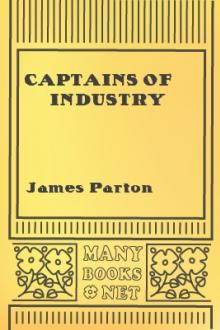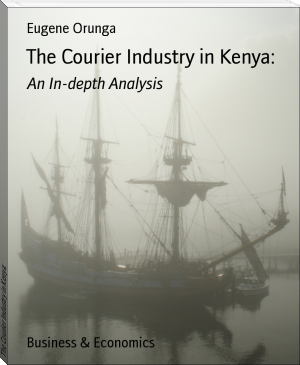Captains of Industry by James Parton (life changing books to read TXT) 📕

- Author: James Parton
- Performer: -
Book online «Captains of Industry by James Parton (life changing books to read TXT) 📕». Author James Parton
"I do further testify that, though it was pretty late ere Mr. Burrows (the clergyman) ended his afternoon's exercise, yet did the major stay in his daughter's house till repetition of both forenoon and afternoon sermons was over, and the duties of the day concluded with prayer; and, after a little stay, to be sure the sun was down, then we mounted, and not till then. The sun did indeed set in a cloud, and after we were mounted, I do remember the major spake of lightening up where the sun set; but I saw no sun."
A personal enemy of the major's brought a charge against him of violating the holy day by starting on his journey before the setting of the sun. The case was brought for trial, and several witnesses were examined. The accuser testified that "he did see Major Robert Pike ride by his house toward the ferry upon the Lord's day when the sun was about half an hour high." Another witness confirmed this. Another testified:—
"The sun did indeed set in a cloud, and, a little after the major was mounted, there appeared a light where the sun went down, which soon vanished again, possibly half a quarter of an hour."
Nevertheless, there were two witnesses who declared that the sun was not down when the major mounted, and so this worthy gentleman, then sixty-four years of age, a man of honorable renown in the commonwealth, was convicted of "profaning the Sabbath," fined ten shillings, and condemned to pay costs and fees, which were eight shillings more. He paid his fine, and was probably more careful during the rest of his life to mount on Sunday evenings by the almanac.
The special glory of this man's life was his steadfast and brave opposition to the witchcraft mania of 1692. This deplorable madness was in New England a mere transitory panic, from which the people quickly recovered; but while it lasted it almost silenced opposition, and it required genuine heroism to lift a voice against it. No country of Europe was free from the delusion during that century, and some of its wisest men were carried away by it. The eminent judge, Sir William Blackstone, in his "Commentaries," published in 1765, used this language:—
"To deny the existence of witchcraft is to flatly contradict the revealed word of God, and the thing itself is a truth to which every nation has in its turn borne testimony."
This was the conviction of that age, and hundreds of persons were executed for practicing witchcraft. In Massachusetts, while the mania lasted, fear blanched every face and haunted every house.
It was the more perilous to oppose the trials because there was a mingling of personal malevolence in the fell business, and an individual who objected was in danger of being himself accused. No station, no age, no merit, was a sufficient protection. Mary Bradbury, seventy-five years of age, the wife of one of the leading men of Salisbury, a woman of singular excellence and dignity of character, was among the convicted. She was a neighbor of Major Pike's, and a life-long friend.
In the height of the panic he addressed to one of the judges an argument against the trials for witchcraft which is one of the most ingenious pieces of writing to be found among the documents of that age. The peculiarity of it is that the author argues on purely Biblical grounds; for he accepted the whole Bible as authoritative, and all its parts as equally authoritative, from Genesis to Revelation. His main point was that witchcraft, whatever it may be, cannot be certainly proved against any one. The eye, he said, may be deceived; the ear may be; and all the senses. The devil himself may take the shape and likeness of a person or thing, when it is not that person or thing. The truth on the subject, he held, lay out of the range of mortal ken.
"And therefore," he adds, "I humbly conceive that, in such a difficulty, it may be more safe, for the present, to let a guilty person live till further discovery than to put an innocent person to death."
Happily this mania speedily passed, and troubled New England no more. Robert Pike lived many years longer, and died in 1706, when he was nearly ninety-one years of age. He was a farmer, and gained a considerable estate, the whole of which he gave away to his heirs before his death. The house in which he lived is still standing in the town of Salisbury, and belongs to his descendants; for on that healthy coast men, families, and houses decay very slowly. James S. Pike, one of his descendants, the well-remembered "J. S. P." of the "Tribune's" earlier day, and now an honored citizen of Maine, has recently written a little book about this ancient hero who assisted to set his fellow-citizens right when they were going wrong.
GEORGE GRAHAM, CLOCK-MAKER, BURIED IN WESTMINSTER ABBEY.It is supposed that the oldest clock in existence is one in the ancient castle of Dover, on the southern coast of England, bearing the date, 1348. It has been running, therefore, five hundred and thirty-six years. Other clocks of the same century exist in various parts of Europe, the works of which have but one hand, which points the hour, and require winding every twenty-four hours. From the fact of so many large clocks of that period having been preserved in whole or in part, it is highly probable that the clock was then an old invention.
But how did people measure time during the countless ages that rolled away before the invention of the clock? The first time-measurer was probably a post stuck in the ground, the shadow of which, varying in length and direction, indicated the time of day, whenever the sun was not obscured by clouds. The sun-dial, which was an improvement upon this, was known to the ancient Jews and Greeks. The ancient Chinese and Egyptians possessed an instrument called the Clepsydra (water-stealer), which was merely a vessel full of water with a small hole in the bottom by which the water slowly escaped. There were marks in the inside of the vessel which showed the hour. An improvement upon this was made about two hundred and thirty-five years before Christ by an Egyptian, who caused the escaping water to turn a system of wheels; and the motion was communicated to a rod which pointed to the hours upon a circle resembling a clock-face. Similar clocks were made in which sand was used instead of water. The hour-glass was a time-measurer for many centuries in Europe, and all the ancient literatures abound in allusions to the rapid, unobserved, running away of its sands.
The next advance was the invention of the wheel-and-weight-clock, such as has been in use ever since. The first instrument of this kind may have been made by the ancients; but no clear allusion to its existence has been discovered earlier than 996, when Pope Sylvester II. is known to have had one constructed. It was Christian Huygens, the famous Dutch philosopher, who applied, in 1658, the pendulum to the clock, and thus led directly to those more refined and subtle improvements, which render our present clocks and watches among the least imperfect of all human contrivances.
George Graham, the great London clock-maker of Queen Anne's and George the First's time, and one of the most noted improvers of the clock, was born in 1675. After spending the first thirteen years of his life in a village in the North of England, he made his way to London, an intelligent and well-bred Quaker boy; and there he was so fortunate as to be taken as an apprentice by Tompion, then the most celebrated clock-maker in England, whose name is still to be seen upon ancient watches and clocks. Tompion was a most exquisite mechanic, proud of his work and jealous of his name. He is the Tompion who figured in Farquhar's play of "The Inconstant;" and Prior mentions him in his "Essay on Learning," where he says that Tompion on a watch or clock was proof positive of its excellence. A person once brought him a watch to repair, upon which his name had been fraudulently engraved. He took up a hammer and smashed it, and then selecting one of his own watches, gave it to the astonished customer, saying: "Sir, here is a watch of my making."
Graham was worthy to be the apprentice of such a master, for he not only showed intelligence, skill, and fidelity, but a happy turn for invention. Tompion became warmly attached to him, treated him as a son, gave him the full benefit of his skill and knowledge, took him into partnership, and finally left him sole possessor of the business. For nearly half a century George Graham, Clock-maker, was one of the best known signs in Fleet Street, and the instruments made in his shop were valued in all the principal countries of Europe. The great clock at Greenwich Observatory, made by him one hundred and fifty years ago, is still in use and could hardly now be surpassed in substantial excellence. The mural arch in the same establishment, used for the testing of quadrants and other marine instruments, was also his work. When the French government sent Maupertuis within the polar circle, to ascertain the exact figure of the earth, it was George Graham, Clock-maker of Fleet Street, who supplied the requisite instruments.
But it was not his excellence as a mechanic that causes his name to be remembered at the present time. He made two capital inventions in clock-machinery which are still universally used, and will probably never be superseded. It was a common complaint among clock-makers, when he was a young man, that the pendulum varied in length according to the temperature, and consequently caused the clock to go too slowly in hot weather, and too fast in cold. Thus, if a clock went correctly at a temperature of sixty degrees, it would lose three seconds a day if the temperature rose to seventy, and three more seconds a day for every additional ten degrees of heat. Graham first endeavored to rectify this inconvenience by making the pendulum of several different kinds of metal, which was a partial remedy. But the invention by which he overcame the difficulty completely, consisted in employing a column of mercury as the "bob" of the pendulum. The hot weather, which lengthened the steel rods, raised the column of mercury, and so brought the centre of oscillation higher. If the column of mercury was of the right length, the lengthening or the shortening of the pendulum was exactly counterbalanced, and the variation of the clock, through changes of the temperature, almost annihilated.
This was a truly exquisite invention. The clock he himself made on this plan for Greenwich, after being in use a century and a half, requires attention not oftener than once in fifteen months. Some important discoveries in astronomy are due to the exactness with which Graham's clock measures time. He also





Comments (0)